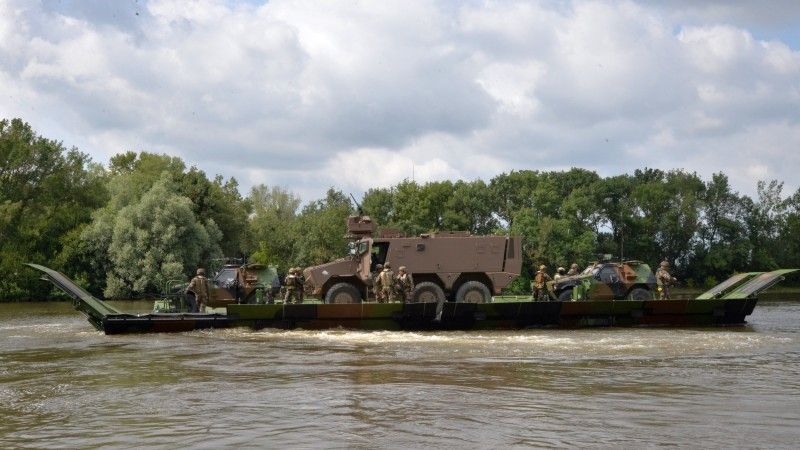New Generation Pontoon Bridges for the Engineering Forces. Execution Contract Signed

In mid-2022, a contract has been signed to procure of river-crossing equipment for the Polish Armed Forces, within the framework of the Daglezja-P programme. The winning bid was placed by the French CNIM Systèmes Industriels company. On 15th of June the French company signed a framework agreement on the delivery of up to thirteen PFM pontoon bridge systems. On 22nd of August meanwhile, the first execution contract was concluded, on delivery of the first systems. The pontoon bridge systems will provide the Polish engineering units with an entirely new set of capabilities, reinforcing the force deployment potential within the European Union.
Daglezja-P Procurement Secured
The framework agreement envisages the acquisition of PFM pontoon bridge systems for the Polish engineering forces, with a maximum value of up to PLN 1.5 bn. That contract is valid until October 2026.
The above price covers the procurement of bridge systems, at a value of PLN 115 million each, while the agreement also includes additional services: training package, documentation, granting of a license, and delivery of spares, and consumables, along with repair kits.
In practical terms, the above means that there is an option to procure up to 13 bridge systems within the budget, that would replace the obsolete PP-64 Wstęga bridges, dating back to the 1960s.
Each of the procured bridge systems will include, among other pieces, 8 pontoon blocks with engines, 4 ramps, equipment, tools, and systems required for building, maintaining, and operating the bridge. 12 trucks with semi-trailers and single passenger/heavy goods vehicle trucks would be used to transport the bridge set.
Any Vehicle Can Cross
Poland has procured the latest PFM system variant, offering high levels of mobility and short deployment times. The bridges make it possible to create crossings for all of the existing, and heaviest fighting vehicles, as well as those planned to be procured by the Polish Armed Forces (and NATO Allies), including M1A2 Abrams SEPv2 and SEPv3 MBTs, with extra equipment installed; T-72/PT-91 MBTs, Leopard 2 MBTs family (A4, A5, PL), and K2/K2PL MBTs. Naturally, the bridges can also accommodate a broad range of logistical/support vehicles, including the M88A2/A3 Hercules ARV, future Kajman systems, engineering vehicles, or even the Krab howitzers.
More importantly, the PFM bridges are also capable enough to allow for river crossing of all semi-trailer tank transporters sets, carrying the heavy vehicles mentioned above. Fielding of the PFM bridge system will translate into a major reinforcement of the capabilities of the Polish engineering units since they will obtain an efficient set of capabilities required to move heavy vehicles across water obstacles. And all of the above will be done with the use of automated pontoon bridge sets that can be deployed relatively quickly. This contributes to the flexibility of use and enhances the levels of survivability.
In Poland, given the country's specific geographical setting (NATO/EU Eastern Flank), as well as a high number of prevalent water obstacles, the capabilities that enhance military mobility play a crucial role. The PFM systems will significantly enhance the efficiency of the operational activities undertaken by the Polish Armed Forces, and the NATO Allies far. This applies to the defensive operations taking place not only in Poland but also in other countries of the region. Thus, they will be seen as an enhancement of military mobility - one of the key defence domain priorities, adopted both by NATO and by the EU.

Photo. CNIM
A high-performance, world-class floating bridge
Optionally, the PFM modules may be controlled via a single remote-control system. This allows for rapid and easy construction of a river crossing with a limited logistical footprint, as there is no need to use auxiliary boats and high numbers of personnel. A 100-meter bridge requires 38 persons to be involved. It can be set up in 30 minutes and accommodate up to 250 vehicles per hour.
Other options allow two types of ramps: multi-purpose tactical ramp or floating ramp. These options can tailor the PFM bridge to fulfill a variety of operational requirements, and work with any other floating bridge system that is in operation.
A single set would make it possible to set up a bridge that would be up to 100 meters long. The bridge offers MLC 90 capacity rating for tracked vehicles, and MLC 100 capacity rating for wheeled vehicles, in normal crossing condition and according to the STANAG 2021 norm. This ensures a safe crossing for any fighting or logistical support asset, including the heaviest MBTs, as well as tank transporters, also used to move other heavy equipment. Another way to use the system set involves employing it as two ferries crossing the gap simultaneously and in opposite directions.
The PFM can also be configured to be transportable by air. This makes it possible to rapidly deploy the pontoon bridges across vast distances (at the strategic airlift level), in a relatively short period.
The PFM pontoon bridge system has been operated for more than 3 decades, by armed forces all over the world. More than 5.5 thousand meters of PFM have been delivered. The French military has recently deployed this system to West Africa, in the summer of 2020.

Photo. Maciej Nędzyński/CO MON
In May 2022 the PFM bridge sets have been used in the NATO Defender Europe-22 exercise organized in Poland. The bridge, deployed by the French 6th Engineering Regiment, was used in a ferry configuration with multi-purpose tactical ramps. This made it possible to ensure interoperability with other floating bridge types operated by NATO. The bridge was also presented to Polish experts, and politicians, including President Andrzej Duda. Following the success in Poland, as the MoD decided to procure the latest variant of the PFM bridge, the system has also been offered to the Armed Forces of Ukraine, among other prospective customers. Ukraine is making procurements of EU-made military equipment, making use of the EU funding support.
About CNIM Systèmes Industriels
CNIM Systèmes Industriels has been founded in 1856, in La Seyne-sur-Mer. The company is a part of the high-tech industry, working in domains such as nuclear, space, and defence. Since the 1980s the company has been delivering pontoon bridges for the French Armed Forces. CNIM Systèmes Industriels also developed the SPRAT (Système de Pose RApide de Travure) wheeled assault bridge back in 2003.
Article prepared in cooperation with CNIM Systèmes Industriels

WIDEO: Defence24 Days 2025: Premier Defence & Security Conference in CEE